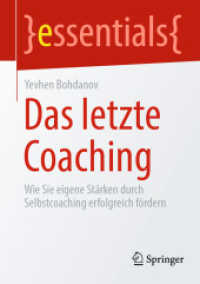Full Description
This edited book explores the use of technology to enable us to visualise the life sciences in a more meaningful and engaging way. It will enable those interested in visualisation techniques to gain a better understanding of the applications that can be used in visualisation, imaging and analysis, education, engagement and training. The reader will also be able to learn about the use of visualisation techniques and technologies for the historical and forensic settings.
The reader will be able to explore the utilisation of technologies from a number of fields to enable an engaging and meaningful visual representation of the biomedical sciences.
In this volume, there are chapters which examine forensic and historical visualisation techniques and digital reconstruction, ultrasound, virtual learning resources and patient utilised software and hardware. The use of HoloLens as a disruptive technology is discussed as well as historical items as a feature in a modern medical curriculum. It concludes with a fascinating chapter on pulse extraction from facial videos. All in all, this volume has something for everyone whether that is faculty, students, clinicians and forensic practitioners, patients, or simply having an interest in one or more of these areas.
Contents
Chapter 1. Pair-Matching Digital 3D Models Of Temporomandibular Fragments Using Mesh-To-Mesh Value Comparison And Implications For Commingled Human Remain Assemblages (Alana S. Acuff, Mara A. Karell, Konstantinos E. Spanakis, And Elena F. Kranioti).- Chapter 2. Forensic Recreation And Visual Representation Of Greek Orthodox Church Saint, Eftichios of Crete (Nectarios Vidakis, Markos Petousis, Despoina Nathena, Elena F. Kranioti, Andreas Manios).- Chapter 3. Virtual Trauma Analysis Of The 19th Century Severed Head Of The Greek Outlaw Stavrou (Elena F. Kranioti, Nikos Tsiatis, Kristina Frandson, Maria Stefanidou, Konstantinos Moraitis).- Chapter 4. Using Computed Tomography (CT) Data To Build 3D Resources For Forensic Craniofacial Identification (Terrie Simmons-Ehrhardt, Catyana R.S. Falsetti, Anthony B. Falsetti).- Chapter 5. Instructional Design Of Virtual Learning Resources For Anatomy Education (Nicolette S. Birbara, Nalini Pather).- Chapter 6. Implementation Of Ultrasound In Anatomy Education (Claire Smith And Seb Barfoot).- Chapter 7. What The Tech? The Management Of Neurological Dysfunction Through The Use Of Digital Technology (Caitlin Carswell And Paul M. Rea).- Chapter 8. Teaching With Disruptive Technology: The Use Of Augmented, Virtual, And Mixed Reality (Hololens) For Disease Education (Zane Stromberga, Charlotte Phelps, Jessica Smith & Christian Moro).- Chapter 9. "Inform the Head, Give Dexterity to the Hand, Familiarise the Heart": Seeing and Using Digitised Eighteenth-Century Specimens in a Modern Medical Curriculum (Frances Osis).- Chapter 10. Contact-Free Pulse Signal Extraction From Human Face Videos: A Review And New Optimised Filtering Approach (Muhammad Waqar, Reyer Zwiggelaar And Bernard Tiddeman).







